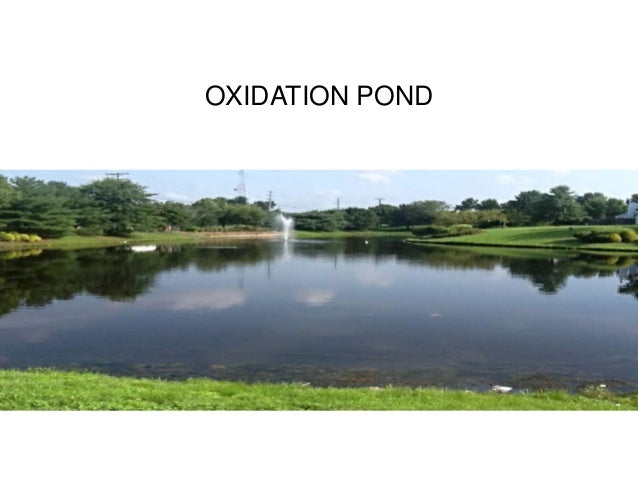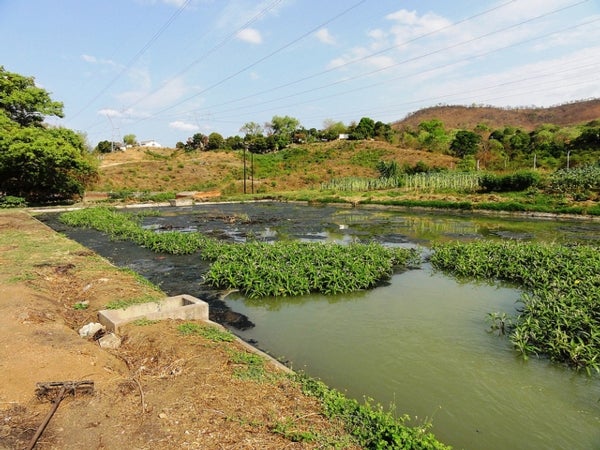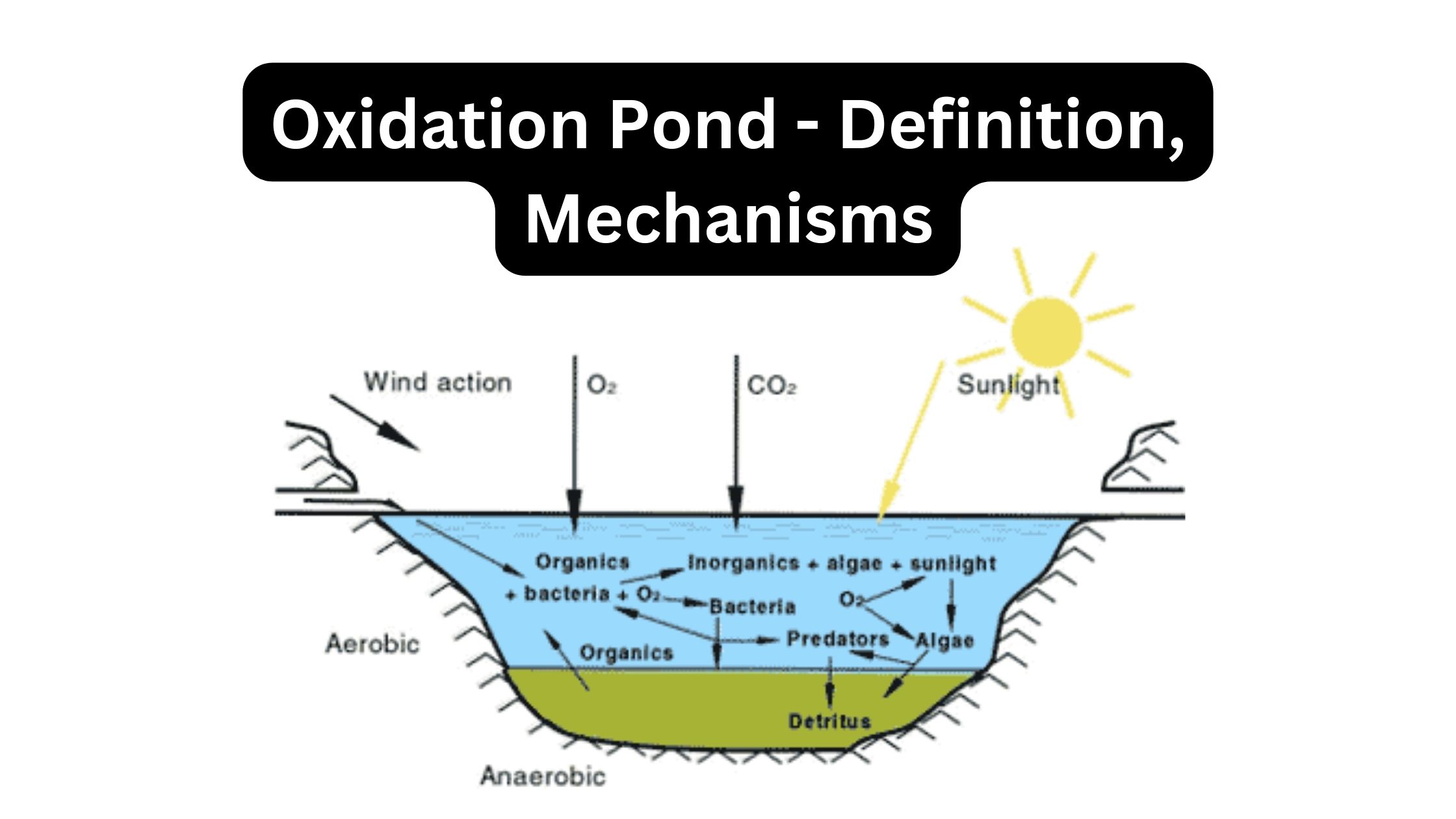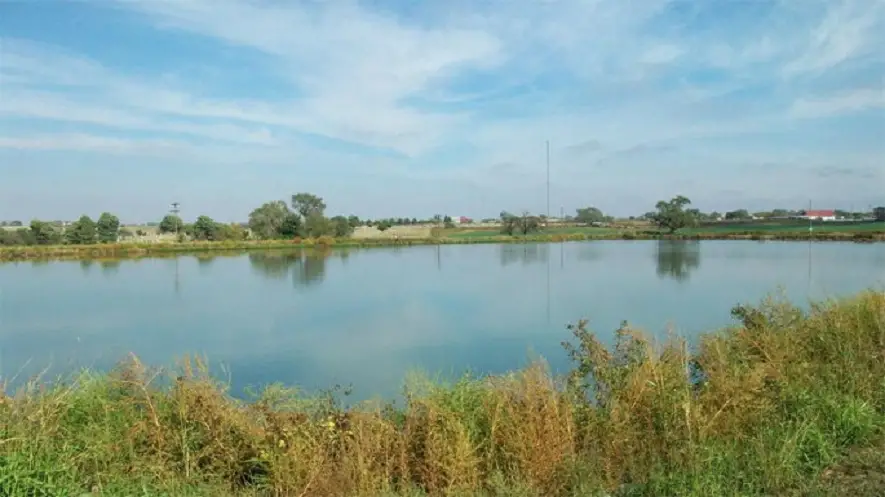When you see a sewage treatment plant or a wastewater treatment plant at work, it uses the same bacteria that are billions of years old that are used in nature to decompose or oxidize organic material except the process is done at a faster rate but with Oxidation Ponds the natural process is put back in control slowing it all down again. What is an Oxidation Pond in wastewater treatment?
Oxidation Ponds are large basins where wastewater is treated by natural processes using bacteria & algae at a slow rate.
Aerobic Pond-bacteria use oxygen
Anaerobic Ponds-bacteria use no oxygen
Facultative Ponds-use both bacteria
Maturation or Tertiary Ponds- aerobic bacteria used for polishing effluents
Oxidation Ponds are considered Advanced oxidation processes (AOPs) a set of treatment procedures designed to remove organic and sometimes inorganic materials in water and wastewater by oxidation set over a big area and a slow period.
Introduction:
In the world of wastewater treatment, few processes are as intriguing and vital as oxidation ponds, also known as stabilization ponds. Offering both an environmentally friendly and cost-effective option for waste management, these ponds rely on sunlight, wind, and microorganisms to break down organic matter. This unique method is rightfully regarded for its potential to sustainably manage wastewater on a massive scale. Today, we delve deep into the workings of such systems, exploring their design, functioning, and the remarkable role they play within the broader framework of wastewater treatment.
What is an Oxidation Pond
Oxidation ponds, also called lagoons or stabilization ponds treatment, are large, shallow ponds designed to treat wastewater through the interaction of sunlight, bacteria, and algae. Algae grow using energy from the sun and carbon dioxide and inorganic compounds released by bacteria in water.
 The quality of wastewater is a factor that decides the type of treatment method that has to be employed. Initially, the stabilization pond treats the strong industrial organic wastes. Domestic wastewater can be subjected to tertiary treatment.
The quality of wastewater is a factor that decides the type of treatment method that has to be employed. Initially, the stabilization pond treats the strong industrial organic wastes. Domestic wastewater can be subjected to tertiary treatment.
The microorganisms in the stabilization pond perform a fundamental role in converting organic wastes into simple forms. Bacteria, algae, fungi, protozoans, insects, larvae, crustaceans, viruses, rotifers, nematodes, etc., are the common microorganisms in the stabilization pond treatment.
Among these microorganisms, bacteria and algae dominate and convert organic matter by reduction-oxidation reactions. Some organisms compete in a stabilization pond, and some live symbiotically to convert the wastewater influent into reclaimed effluent.
For the oxidation of biodegradable organic waste, there must be considerable demand for oxygen. The bacteria need oxygen to convert the organics into simple inorganic compounds. The heterotrophic bacteria fulfill their oxygen requirement through the oxygen released by the algae and the atmospheric oxygen
Oxidation pond refers to the stabilization pond stabilizing the domestic, trade, industrial wastes, etc., by the microbial interaction (primarily bacteria and algae). It seems like a large shallow pond with a 2-6 feet height of water body. Oxidation pond requires the presence of sunlight and oxygen for the secondary treatment of domestic and trade wastes.
The Role of Oxidation Ponds in Wastewater Treatment
Oxidation ponds, also known as stabilization ponds or lagoons, play a significant role in wastewater treatment. These are shallow basins or ponds designed to treat wastewater through natural processes, primarily biological and physical mechanisms. Here are key aspects of the role of oxidation ponds in wastewater treatment:
- Biological Treatment:
- Aerobic Conditions: Oxidation ponds are typically aerobic, meaning they promote the growth of aerobic microorganisms (those that require oxygen). These microorganisms help break down organic matter in the wastewater through biological processes, such as aerobic digestion.
- Algae Growth: Algae also thrive in oxidation ponds. Algae contribute to the treatment process by photosynthesis, absorbing nutrients like nitrogen and phosphorus and producing oxygen.
- Natural Processes:
- Sunlight Exposure: Oxidation ponds are usually exposed to sunlight, promoting the growth of algae and enhancing the natural treatment processes. Sunlight helps in the breakdown of certain organic compounds and pathogens.
- Sedimentation: Larger particles in the wastewater settle to the bottom of the pond through sedimentation, further contributing to the removal of solids from the water.
- Pathogen Reduction:
- Natural Die-Off: The combination of sunlight exposure, predation by organisms in the pond, and other natural processes contributes to the reduction of pathogenic organisms in the wastewater.
- Nutrient Removal:
- Nitrogen and Phosphorus Removal: Algae and other microorganisms in oxidation ponds play a role in the uptake of nutrients like nitrogen and phosphorus, helping to reduce nutrient concentrations in the treated water.
- Low-Energy Treatment:
- Low-Energy Requirements: Oxidation ponds are considered a low-energy treatment option compared to some other wastewater treatment methods. They rely on natural processes and require minimal mechanical equipment.
- Land Treatment:
- Integration with Land Use: Oxidation ponds can be integrated with land use planning. After treatment, the effluent can be used for irrigation, providing a sustainable and beneficial reuse of treated wastewater.
- Limitations:
- Climate Dependence: The efficiency of oxidation ponds can be influenced by climate conditions. Cold climates may slow down biological processes, affecting treatment efficiency.
Oxidation ponds are an effective and environmentally friendly method for treating wastewater, leveraging natural processes to reduce contaminants and improve the quality of effluent water.

An oxidation pond wastewater treatment system chiefly works using natural processes, typically favoring those that depend on aerobic bacteria, oxygen, and sunlight to purify the water. These three elements supply the necessary conditions for the natural breakdown of harmful contaminants in the wastewater.
These ponds are generally shallow, letting sunlight reach a considerable portion of the water’s depth, thereby encouraging the growth of the algae which produce the oxygen that the bacteria need to work effectively. They’re a practical solution that integrates naturally occurring processes effectively to purify wastewater efficiently.
Notably, oxidation ponds are generally used in conjunction with other methods as part of an extensive wastewater treatment system. Usually, they are followed by a secondary treatment process for further purification and removal of any remaining solid particles in suspension or any other components that need to be eliminated.
It’s critical to note that the effective implementation of oxidation pond wastewater treatment depends on several factors. These include the pond’s size, depth, the amount and type of wastewater it has to treat, and the aerobic bacteria’s abundance and activity levels. Each of these factors can significantly affect the efficacy of the treatment process and must be carefully controlled to ensure optimal results.
Despite their simplicity, oxidation ponds offer several key benefits in the wastewater treatment process. They’re economical, and easy to operate, and maintain, demonstrating excellent performance in removing organic and inorganic contaminants from waste water. Not only that, but their reliance on natural processes significantly reduces their environmental impact compared with more technologically advanced treatment methods.
Naturally occurring bacteria and oxygen processes are utilized to break down harmful substances and remove them from the water. These processes are also self-regulating, which means that they adjust to variations in the waste water’s load, contributing to the pond’s long-term sustainability and effectiveness.
How an Oxidation Pond Waste Water Treatment Works
Oxidation ponds, also known as lagoons or stabilization ponds, are a type of wastewater treatment system that relies on natural processes to treat sewage and industrial wastewater. Here’s a step-by-step explanation of how an oxidation pond wastewater treatment works:
- Inflow of Wastewater:
- Raw sewage and wastewater from households, industries, or other sources are directed into the oxidation pond.
- Primary Treatment:
- Larger solid particles in the wastewater settle to the bottom of the pond through a process called sedimentation. This primary treatment helps in removing suspended solids from the water.
- Aerobic Biological Treatment:
- The oxidation pond is designed to encourage aerobic conditions, meaning it promotes the growth of microorganisms that thrive in the presence of oxygen.
- Aerobic bacteria and other microorganisms break down organic matter in the wastewater through processes such as aerobic digestion. This helps to further reduce the organic content of the water.
- Algae Growth and Photosynthesis:
- Sunlight exposure in the oxidation pond promotes the growth of algae. Algae play a crucial role in the treatment process through photosynthesis.
- During photosynthesis, algae absorb carbon dioxide and release oxygen, contributing to the oxygenation of the pond. Algae also absorb nutrients like nitrogen and phosphorus from the water.
- Nutrient Uptake:
- Algae and other microorganisms present in the pond take up nutrients such as nitrogen and phosphorus, helping to reduce nutrient concentrations in the water.
- Natural Die-Off and Predation:
- Pathogenic organisms present in the wastewater are naturally reduced through processes like predation by organisms within the pond and natural die-off.
- Final Settlement:
- The remaining suspended solids, including microorganisms, settle to the bottom of the pond as the water moves through the system.
- Effluent Discharge:
- Treated water, known as effluent, is discharged from the oxidation pond. The effluent quality should meet regulatory standards for discharge into receiving waters or for other designated uses.
- Potential Reuse or Disposal:
- Depending on local regulations and the quality of the treated water, the effluent may be suitable for various purposes, including irrigation or release into natural water bodies.
- Maintenance and Monitoring:
- Regular monitoring of the oxidation pond’s performance is essential to ensure effective treatment. Maintenance activities may include removing excess sludge and ensuring proper aeration.
Oxidation ponds are a passive and cost-effective method of wastewater treatment, relying on natural processes and sunlight exposure. However, their efficiency can be influenced by factors such as climate, pond design, and the characteristics of the wastewater being treated. Regular monitoring and adherence to best practices are crucial for the successful operation of oxidation pond wastewater treatment systems.
The secondary treatment of the organic and inorganic waste coming from raw sewage and industrial effluents is necessary. The direct disposal of the wastewater to the aquatic system can affect the life of water bodies and the quality of water as well.
The mechanism or working of the oxidation pond can be made simple by understanding the following steps:
- First, the bacteria present in the oxidation pond will oxidize the organic waste of the domestic as well as industrial sewage. By doing this, bacteria release carbon dioxide, water, and ammonia.
- The algal growth occurs in the presence of sunlight. It utilizes the inorganic wastes formed by the organic matter decomposition and releases oxygen.
From the above two mechanisms, it is clear that the algae and bacteria work mutually to fulfill each other’s requirements. The bacteria use oxygen released by the algae to oxidize the biodegradable organics. The oxidation of organic waste by the bacteria releases carbon dioxide. Later, algae harness carbon dioxide to reduce inorganic wastes like nitrogen, phosphorus compounds, etc.
Treating Wastewater: Oxidation Pond-Stabilization Pond-Sewage Treatment
Oxidation ponds, also called lagoons or stabilization ponds, are large, shallow ponds designed to treat wastewater through the interaction of sunlight, bacteria, and algae. Algae grow using energy from the sun and carbon dioxide and inorganic compounds released by bacteria in water. During the process of photosynthesis, the algae release oxygen needed by aerobic bacteria.
Types of Oxidation Ponds are:
- Aerobic Ponds-Large ponds that treat wastewater with bacteria and algae requiring oxygen
- Anaerobic Ponds-Require no Dissolved oxygen-Anaerobic digestion happens at the bottom of the pond
- Facultative Ponds- Use anaerobic bacteria at night and aerobic bacteria produced by algae during the day to degrade waste.
- Maturation or Tertiary Ponds-finishing pond -These are aerobic ponds used for effluent polishing-reduction of fecal coliform- nutrients removed (nitrogen and phosphorous)
What is the Difference Between a Storm Water System and a Sanitary Sewer System?
Storm Water System:
- Collects outside runoff rain & snowmelt
- Transports it to waterways preventing flooding-Under NPDES Permit
Sanitary Sewer System:
- Collects and transports for treatment of domestic, commercial & industrial wastewater from inside buildings
- Normally Separate from the Storm System–Under NPDES Permit ..……………………………………………………………………………………………………… Read more

Do Oxidation Ponds Remove Heavy Metals-Wastewater Treatment
No, Oxidation ponds are generally not highly effective in removing heavy metals from wastewater. The primary mechanisms in oxidation ponds, such as biological processes and sedimentation, are more geared towards the removal of organic matter and pathogens. Heavy metals, being inorganic pollutants, often require specialized treatment methods such as chemical precipitation, ion exchange, or membrane filtration for efficient removal in wastewater treatment systems.
During the process of photosynthesis, the algae release oxygen needed by aerobic bacteria. Mechanical aerators are sometimes installed to supply yet more oxygen, thereby reducing the required size of the pond. Sludge deposits in the pond must eventually be removed by dredging. Algae remaining in the pond effluent can be removed by filtration or by combining chemical treatment and settling.
The biochemical oxygen demand or BOD indicates the amount of putrescible organic material in sewage; the more organic material there is in the sewage, the higher the BOD, which is the amount of oxygen required by microorganisms to decompose break down, and treat the organic substances in sewage.
What are the 3 Stages of Wastewater Treatment?
- Primary Stage-separates settable organic solids & inorganic material that won’t degrade
- Secondary Stage-removes suspended & soluble solids converting them to settable solids using Biological Oxidation
- The tertiary stage uses chemical & physical treatment to create H2O closer to potable quality .……………………………………………………………………………………… Read more
It is among the most important parameters for the design and operation of sewage treatment plants. Industrial sewage may have BOD levels many times that of domestic sewage. The BOD of storm sewage is of particular concern when it is mixed with domestic sewage in combined sewerage systems
Dissolved oxygen is an important water quality factor for lakes and rivers. The higher the concentration of dissolved oxygen, the better the water quality. When sewage enters a lake or stream, decomposition of the organic materials begins. Oxygen is consumed as microorganisms use it in their metabolism.
This can quickly deplete the available oxygen in the water. When the dissolved oxygen levels drop too low, trout and other aquatic species soon perish. In fact, if the oxygen level drops to zero, the water will become septic. The decomposition of organic compounds without oxygen causes undesirable odors usually associated with septic or putrid conditions.
What is COD in Wastewater Treatment
COD stands for Chemical Oxygen Demand, and it is a critical parameter and indicator that is used to quantify the amount of organic pollutants in wastewater, especially Oxidation and Stabilization Ponds.
COD measures the total amount of oxygen required to chemically oxidize both biodegradable and non-biodegradable organic matter in water. It is an essential indicator of the water’s pollution level and the potential impact of the wastewater on the receiving environment. COD is often expressed in milligrams of oxygen per liter (mg/L) of water.
High COD levels in wastewater indicate a greater amount of organic compounds that can be oxidized. While COD is a useful measure of overall organic pollution, it does not specifically identify the types of pollutants present. Therefore, it is often used in conjunction with other water quality parameters to assess the effectiveness of wastewater treatment processes and to ensure compliance with environmental regulations.
Conclusion:
In conclusion, stabilization ponds and oxidation ponds play an important role in wastewater treatment. They serve as nature-simulated systems, facilitating pollution reduction through biological, biochemical, and physical processes. The eventual oxidation in these ponds effectively decomposes organic matter and residual waste, leading to the purification of wastewater. Understanding the exact functioning of oxidation ponds can lead to improved wastewater management strategies. Thus, these ponds serve as a crucial and environmentally friendly method for waste disposal and water conservation, reiterating the need for their sustained operation and scientific study.
What is a Trickling Filter in Wastewater Treatment?
Trickling filters are used to remove organic matter from wastewater an aerobic treatment system that uses microbes attached to a filter medium rock, gravel, or plastic that removes organic matter from wastewater sprayed on it, followed by a recirculation tank It can handle peak shock loads to loads……………………………………………………………………. Read more

References: NASA Oxidation Ponds
Biology Reader-What is an Oxidation Pond?
FAQ’s
- Can oxidation ponds effectively remove all types of contaminants from wastewater? Oxidation ponds are primarily designed for the treatment of organic matter and pathogens in municipal wastewater. While they are effective for these purposes, they may not efficiently remove certain contaminants such as heavy metals or industrial chemicals. Specialized treatment methods may be needed for specific pollutants.
- How do climate conditions impact the performance of oxidation ponds? Climate conditions, particularly temperature, can affect the efficiency of biological processes in oxidation ponds. Cold climates may slow down microbial activity, potentially reducing the treatment effectiveness. Understanding climate dependence is crucial for designing and operating oxidation ponds in different regions.
- What are the potential uses for the treated effluent from oxidation ponds? Depending on the quality of the treated water, the effluent from oxidation ponds can be used for various purposes, including irrigation, industrial processes, or even discharge into natural water bodies. The suitability for reuse or disposal depends on local regulations and the specific characteristics of the treated water.

